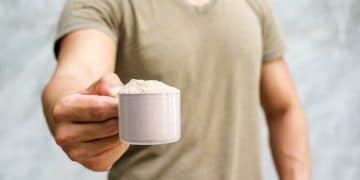The Truth About Creatine: Benefits, Risks, and Dosage for 2025

Unraveling the complexities of creatine, this article explores its established benefits for athletic performance and cognitive health, scrutinizes potential risks and side effects, and provides evidence-based dosage recommendations for optimal safety and efficacy in 2025.
Delving into The Truth About Creatine: Benefits, Risks, and Dosage for 2025, this article aims to demystify one of the most widely researched and utilized supplements in the fitness world. What exactly is creatine, and how can it impact your physical and cognitive performance?
Understanding Creatine: More Than Just a Muscle Builder
Creatine is a naturally occurring organic compound that plays a pivotal role in the energy supply of cells, particularly muscle cells. Synthesized primarily in the liver, kidneys, and pancreas from amino acids, it’s also found in red meat and fish. For decades, athletes and fitness enthusiasts have turned to creatine supplementation to enhance performance, but its benefits extend beyond just muscle growth.
Research continues to uncover vast applications for this compound, moving it beyond a mere bodybuilding supplement and into the realm of general health and well-being. Its fundamental mechanism involves replenishing adenosine triphosphate (ATP), the primary energy currency of the body, allowing for sustained high-intensity efforts.
What is Creatine and How Does it Work?
At its core, creatine is a nitrogenous organic acid that helps supply energy to cells throughout the body, predominantly muscle cells. Approximately 95% of the body’s creatine is stored in skeletal muscles. Here’s a simplified breakdown of its function:
- ATP Regeneration: Creatine helps produce ATP, the molecule used by cells for energy.
- Phosphocreatine Stores: It boosts phosphocreatine stores in muscles, allowing for rapid ATP regeneration during intense, short bursts of activity.
- Cellular Hydration: Creatine draws water into muscle cells, leading to increased cell volume, which some hypothesize contributes to muscle growth.
The constant cycle of ATP utilization and regeneration is vital for all bodily functions, but especially for muscle contraction during exercise. By increasing the available pool of phosphocreatine, creatine supplementation essentially acts as an energy buffer, delaying fatigue and enabling greater work output.
The Historical Context and Evolution of Creatine Use
Creatine first gained significant attention in the early 1990s, particularly after the 1992 Barcelona Olympics, where several medal-winning athletes reportedly used it. Since then, it has become one of the most studied dietary supplements, with thousands of scientific papers investigating its effects. Initially, its use was primarily confined to strength and power athletes, but as understanding of its mechanisms grew, so did its widespread appeal.
The early days of creatine supplementation were often marred by anecdotal claims and unsubstantiated hype. However, rigorous scientific scrutiny over the past three decades has solidified its position as a safe and effective ergogenic aid when used appropriately. This evolution from a niche supplement to a mainstream staple reflects a growing body of evidence supporting its diverse applications.
As we move into 2025, the narrative around creatine continues to expand, encompassing not only its well-established athletic benefits but also emerging insights into its cognitive and therapeutic potential.
Proven Benefits of Creatine: Beyond Muscle Gain
While often associated with athletes and bodybuilders, the proven benefits of creatine extend far beyond simply building muscle. Its ability to enhance energy production at a cellular level contributes to a wide array of physiological improvements, making it a valuable supplement for various demographics.
Decades of research have consistently demonstrated its efficacy in improving athletic performance, but newer studies are shedding light on its neuroprotective properties and potential role in general health. Understanding these multifaceted benefits is crucial for appreciating creatine’s full value.
Enhanced Athletic Performance and Exercise Capacity
Creatine’s most well-documented benefit is its profound impact on athletic performance. By increasing phosphocreatine stores in muscles, it facilitates the rapid regeneration of ATP, allowing athletes to perform more intense, short-duration activities. This translates to measurable improvements in several key areas:
- Strength and Power: Users often experience increased maximal strength and power output during resistance training and sports requiring explosive movements.
- Exercise Performance: It enables greater work output over multiple sets or repetitions, delaying fatigue in activities like sprinting or weightlifting.
- Muscle Mass Gains: While not a direct muscle builder itself, the increased training volume and intensity afforded by creatine can lead to greater muscle hypertrophy over time.
These benefits are particularly pronounced in activities involving short bursts of intense effort, such as weightlifting, sprinting, and team sports. The cumulative effect of better training sessions leads to superior long-term adaptations and performance gains.
Cognitive Function and Brain Health
Beyond its well-known effects on physical performance, creatine is gaining significant attention for its potential role in cognitive function and brain health. The brain, like muscles, requires a high supply of ATP for optimal function. Creatine can cross the blood-brain barrier and increase creatine and phosphocreatine levels in the brain.
Emerging research suggests several cognitive benefits:
- Improved Memory: Studies indicate that creatine supplementation can enhance short-term memory, especially in conditions of sleep deprivation or mental fatigue.
- Enhanced Intelligence: Some research points to improvements in working memory and general intelligence, particularly in older adults or those with lower baseline creatine levels.
- Neuroprotection: Creatine may offer neuroprotective effects, potentially reducing the severity of brain injuries and supporting recovery from conditions like traumatic brain injury (TBI) or stroke.
While the research in this area is still evolving, the implications for cognitive enhancement and neurological health are profound, suggesting creatine could be relevant for a wider demographic than previously thought.

Other Potential Therapeutic Applications
The therapeutic potential of creatine extends to various clinical conditions, although more research is needed to solidify these uses. Its role in energy metabolism makes it a fascinating compound for conditions marked by energy deficits or muscle wasting.
Some areas of active investigation include:
- Neurodegenerative Diseases: Potential benefits are being explored for conditions like Parkinson’s disease, Huntington’s disease, and ALS, where energy metabolism is often compromised.
- Depression and Mood Disorders: Preliminary studies suggest creatine might have antidepressant effects and could be a valuable adjunct therapy for mood stabilization.
- Bone Health: Research indicates it may promote bone formation and reduce bone resorption, potentially benefiting bone mineral density.
While these therapeutic applications are still largely in the exploratory phase, they highlight the dynamic future of creatine research and its potential to contribute to broader health and wellness outcomes beyond the gym.
Potential Risks and Side Effects of Creatine
Despite its extensive research and generally recognized safety profile, creatine use is not entirely without potential risks or side effects. It’s crucial for users to be aware of these considerations and to consult with a healthcare professional, especially if they have pre-existing conditions or are taking other medications.
While most reported side effects are mild and transient, understanding the nuances of creatine’s impact on the body is essential for informed decision-making. The vast majority of studies support its safety, but individual responses can vary.
Commonly Reported Side Effects
The most frequently reported side effects associated with creatine supplementation are generally mild and often transient. These typically occur during the initial “loading” phase when higher doses are consumed:
- Gastrointestinal Distress: Some individuals may experience stomach upset, nausea, or diarrhea, particularly with high doses in a single serving. Distributing the dosage throughout the day or taking it with food can often mitigate these issues.
- Muscle Cramping: While sometimes anecdotally
reported, research does not consistently link creatine to increased muscle cramping or dehydration. Adequate hydration is always recommended for athletes, regardless of creatine use. - Water Retention: Creatine draws water into muscle cells, leading to an increase in intracellular water. This can manifest as a slight weight gain (typically 1-3 kg) in the initial weeks of supplementation. This is primarily water retention, not fat gain, and is part of creatine’s mechanism of action.
These side effects are generally not a cause for concern and often resolve as the body adapts to the supplementation. Maintaining adequate hydration is key to minimizing any potential discomfort.
Concerns Regarding Kidney and Liver Function
One of the most persistent, yet largely debunked, myths surrounding creatine is its alleged detrimental effect on kidney and liver function. Extensive research, including long-term studies, has consistently shown that creatine supplementation, when used at recommended dosages, does not adversely impact kidney or liver function in healthy individuals.
However, caution is still advised for individuals with pre-existing kidney disease. Anyone with compromised renal function should strictly avoid creatine or use it only under the direct supervision of a healthcare provider. For healthy individuals, the available evidence overwhelmingly supports its safety for these organs. Creatinine, a byproduct of creatine metabolism, is used as a marker for kidney function, which can sometimes lead to confusion. Creatine supplementation can elevate creatinine levels, but this does not necessarily indicate kidney damage in healthy individuals.
Drug Interactions and Contraindications
While generally safe, creatine can interact with certain medications and might be contraindicated in specific medical conditions. It’s crucial to disclose
creatine use to your doctor, particularly if you are on medications or have chronic health issues.
- Diuretics and NSAIDs: Concurrent use of creatine with certain diuretics or non-steroidal anti-inflammatory drugs (NSAIDs) like ibuprofen has been speculated to increase the risk of kidney problems, though definitive evidence is limited.
- Kidney Disease: As mentioned, individuals with pre-existing kidney disease should avoid creatine.
- Pregnancy and Breastfeeding: There is insufficient research on creatine safety during pregnancy and breastfeeding, so it is generally advised to avoid its use in these populations.
- Bipolar Disorder: Some anecdotal reports suggest creatine might exacerbate manic episodes in individuals with bipolar disorder, though scientific evidence is scarce.
Always err on the side of caution and consult a healthcare professional before starting creatine, especially if you have any underlying medical conditions or are taking prescription medications.
Optimal Creatine Dosage for 2025: What the Science Says
Determining the optimal creatine dosage is crucial for maximizing its benefits while minimizing the potential for side effects. The scientific community has largely converged on specific protocols that are both effective and safe for most healthy individuals. These guidelines account for different approaches, from rapid loading to sustained maintenance.
As we move into 2025, the recommendations remain consistent, emphasizing a calculated approach based on body weight and activity level. It’s important to differentiate between loading phases and maintenance phases, as the body’s saturation levels influence dosage requirements.
Loading Phase vs. Maintenance Phase: Which is Right for You?
Creatine supplementation typically involves two phases: a loading phase and a maintenance phase. The goal of the loading phase is to rapidly saturate muscle creatine stores, while the maintenance phase aims to keep those stores elevated.
- Loading Phase: This involves taking a higher dose of creatine for a short period (typically 5-7 days) to quickly maximize muscle creatine levels. The common recommendation is 20 grams per day, divided into 4 servings of 5 grams each. While not strictly necessary, a loading phase can accelerate the onset of benefits.
- Maintenance Phase: After the loading phase, a lower daily dose is sufficient to maintain saturated muscle creatine stores. The typical maintenance dose is 3-5 grams per day. For larger individuals or highly active athletes, doses up to 10 grams per day might be considered, though evidence for added benefits beyond 5 grams is limited.
For those who prefer a simpler approach or want to avoid potential gastrointestinal discomfort from loading, you can bypass the loading phase entirely and just start with the maintenance dose of 3-5 grams daily. Muscle creatine stores will still saturate, albeit more slowly (typically within 3-4 weeks).
Timing and Consumption Recommendations
The timing of creatine consumption has been a subject of debate, but research suggests that the specific timing relative to workouts is less critical than consistent daily intake. The goal is to keep muscle creatine stores saturated over time.
- Any Time of Day: Creatine can be taken at any time of the day. Consistency is the most important factor.
- Post-Workout: Some studies suggest a slight advantage to taking creatine post-workout, especially when combined with carbohydrates and protein, as insulin may help transport creatine into muscle cells.
- With Meals: Taking creatine with meals can also aid absorption and may help reduce the likelihood of stomach upset.
Mixing creatine with water, juice, or a protein shake is common. Ensure adequate fluid intake throughout the day, as creatine draws water into muscle cells.
Adjusting Dosage for Specific Populations
While the 3-5 gram maintenance dose is widely applicable, dosage adjustments might be considered for specific populations based on factors like body weight, age, and activity level.
- Body Weight: For larger individuals (over ~90-100 kg), a maintenance dose closer to 5g or potentially up to 7-10g might be more appropriate to fully saturate muscle stores, though consistently higher doses may not yield significantly greater benefits.
- Older Adults: While generally safe and potentially beneficial for older adults (e.g., for sarcopenia), a conservative starting dose and medical consultation are recommended.
- Adolescents: Due to limited long-term research in this age group, creatine is generally not recommended for individuals under 18 unless under strict medical supervision and for specific validated purposes.
Personalized consultation with a healthcare professional or a registered dietitian is always recommended to tailor creatine dosage to individual needs and health status.
Choosing the Right Creatine: Monohydrate vs. Others
The market for creatine supplements has expanded significantly, leading to a confusing array of different forms beyond the traditional monohydrate. Navigating these options can be challenging, but understanding the scientific evidence behind each type is key to making an informed decision.
While various forms exist, the overwhelming scientific consensus points to one clear winner in terms of efficacy, safety, and cost-effectiveness. The subtle differences between forms often boil down to minor absorption variations or marketing claims rather than substantial improvements in performance.
Creatine Monohydrate: The Gold Standard
Creatine monohydrate stands as the most researched, effective, and cost-efficient form of creatine available. Thousands of studies have validated its benefits and safety profile, making it the “gold standard” against which all other forms are measured.
- Superior Absorption: It is well-absorbed by the body, with nearly 100% bioavailability.
- Proven Efficacy: Consistently shown to improve strength, power, and muscle mass across diverse populations and training protocols.
- Cost-Effective: It is significantly more affordable than other designer forms of creatine, offering the best value for money.
- Safety Profile: Its long history of safe use and extensive research firmly establish its safety for healthy individuals.
When considering creatine supplementation, starting with creatine monohydrate is almost always the recommended first step due to its robust evidence base.
Exploring Other Forms: Kre-Alkalyn, HCL, Ethyl Ester, etc.
Beyond monohydrate, numerous other forms of creatine have emerged, each claiming superior absorption, fewer side effects, or enhanced effectiveness. However, scientific evidence supporting these claims is often limited or contradictory:
- Creatine HCL (Hydrochloric Acid): Marketed for better solubility and absorption, reducing the need for a loading phase and theoretically minimizing water retention. While it is more soluble, there’s no strong evidence it’s more effective than monohydrate at saturating muscle creatine stores or producing superior performance benefits.
- Kre-Alkalyn (Buffered Creatine): Advertised as having a higher pH to prevent conversion to creatinine (a waste product) in the stomach, thereby increasing absorption. Research has largely failed to show any significant advantage over creatine monohydrate in terms of muscle uptake or efficacy.
- Creatine Ethyl Ester (CEE): Designed to be more lipophilic for better absorption. However, studies have shown CEE is less effective than monohydrate, as it rapidly degrades to creatinine in the digestive tract, resulting in poor absorption into muscles.
The proliferation of these alternative forms is often driven by marketing rather than scientific innovation. For the vast majority of users, sticking with creatine monohydrate is the most sensible and evidence-based choice.
What to Look for in a Creatine Product
When purchasing creatine, regardless of the form, it’s essential to ensure product quality and purity. The supplement industry, while regulated, still has inconsistencies. Key considerations include:
- Third-Party Testing: Look for products that are third-party tested (e.g., by NSF Certified for Sport, Informed-Sport, USP) to ensure purity, absence of contaminants, and accurate labeling. This is particularly important for competitive athletes.
- Purity: Ensure the product is 100% pure creatine with no fillers or unnecessary additives.
- Micronized Form: Micronized creatine monohydrate has smaller particles, which can improve solubility and mixability, potentially reducing stomach discomfort for some.
Investing in a reputable brand that prioritizes quality and transparency will ensure you’re getting a safe and effective product.
Optimizing Creatine Use: Synergies and Lifestyle Factors
While creatine is effective on its own, its benefits can be further amplified when integrated into a holistic approach that includes proper nutrition, strategic timing, and consistent training. Understanding how creatine interacts with other elements of a healthy lifestyle can help users maximize its potential.
It’s not merely about taking a pill; it’s about creating an environment where the body can optimally utilize the supplement. This involves considering dietary choices, hydration status, and the type of physical activity undertaken.
Combining Creatine with Other Supplements
Creatine works synergistically with certain other supplements, potentially enhancing its effects or supporting overall performance. Some common and evidence-backed combinations include:
- Carbohydrates: Consuming creatine with carbohydrates (or a carbohydrate-protein mix) can enhance creatine uptake into muscle cells due to an insulin response. This is often leveraged during the loading phase or post-workout.
- Protein: Essential for muscle repair and growth, protein combined with creatine can support overall muscle building efforts. Many protein powders already contain creatine.
- Beta-Alanine: Both beta-alanine and creatine enhance high-intensity exercise performance, but through different mechanisms. Beta-alanine buffers lactic acid, while creatine supports ATP regeneration. Combining them can lead to additive benefits for endurance and power.
While other combinations exist, these are some of the most well-researched and widely accepted for their synergistic effects with creatine.
Hydration, Diet, and Training Protocols
Optimal creatine efficacy is highly dependent on overall lifestyle factors. No supplement can fully compensate for poor diet, inadequate hydration, or inconsistent training.
- Hydration: Given that creatine draws water into muscle cells, maintaining sufficient hydration is critical. Aim for at least 8-10 glasses of water daily, increasing intake during intense training or hot weather.
- Balanced Diet: A diet rich in whole foods, lean proteins, complex carbohydrates, and healthy fats provides the necessary building blocks for muscle growth, energy production, and overall health, complementing creatine’s effects.
- Consistent Training: Creatine’s benefits are realized by enabling more effective training sessions. Regular, progressive overload in resistance training is essential for seeing gains in strength and muscle mass. Without a proper training stimulus, creatine’s benefits will be significantly diminished.
Viewing creatine as an adjunct to a well-structured training and nutrition plan, rather than a standalone miracle pill, is key to successful supplementation.

Cycling Creatine: Necessary or Optional?
The practice of “creatine cycling” (periods of use followed by periods of abstinence) was once common, stemming from fears of receptor downregulation or reduced endogenous creatine production. However, current scientific evidence suggests that cycling creatine is generally not necessary for healthy individuals.
- No Receptor Downregulation: Research indicates that continuous creatine use does not lead to a decrease in the effectiveness of its transporters or receptors.
- Endogenous Production: The body continues to produce its own creatine even during supplementation; natural production typically resumes at normal levels shortly after cessation.
- Consistent Benefits: Continuous maintenance dosing ensures consistently elevated muscle creatine stores, which sustains the benefits for performance and cognition.
While taking a break from creatine is unlikely to cause harm, it’s also not required for efficacy or safety, simplifying the supplementation regimen for most users who aim for sustained benefits.
Future Outlook for Creatine in 2025 and Beyond
As we advance into 2025 and beyond, the scientific understanding and application of creatine continue to evolve. While its role in sports performance is well-established, ongoing research promises to uncover even more diverse uses, solidifying its place not just as a performance enhancer but as a compound with broad health implications.
The future outlook for creatine is marked by deeper exploration into its therapeutic potential, personalized approaches to supplementation, and a growing emphasis on its long-term health benefits, especially in an aging population.
Emerging Research and New Applications
The research landscape for creatine is dynamic, with scientists continually exploring new frontiers. Beyond athletic and cognitive benefits, emerging areas of interest include:
- Maternal and Fetal Health: Preliminary studies are investigating creatine’s role in supporting brain development in fetuses and newborns, and its potential benefits for maternal health during pregnancy.
- Metabolic Disorders: Its involvement in energy metabolism makes creatine a candidate for research into conditions like diabetes and other metabolic syndromes.
- Chronic Diseases: Further research is expected on its role in combating muscle wasting in chronic diseases and its neuroprotective effects in various neurological disorders beyond those previously mentioned.
These emerging applications highlight creatine’s versatility and its potential to become an even more integral part of health and wellness strategies.
Personalized Creatine Use and Precision Nutrition
The future of supplementation, including creatine, is likely to lean more towards personalized nutrition. Advances in genetic testing and metabolic profiling could allow for highly individualized creatine recommendations based on an individual’s unique biological makeup and specific needs.
- Genetic Predisposition: Understanding genetic variations that affect creatine synthesis, transport, and metabolism could lead to more precise dosage recommendations.
- Biomarker Monitoring: Regular monitoring of muscle creatine levels and other relevant biomarkers could help tailor supplementation strategies for optimal saturation and benefit.
- Tailored for Specific Goals: Depending on whether the user’s primary goal is athletic performance, cognitive enhancement, or therapeutic support, dosages and forms might be more finely tuned.
This move towards precision nutrition ensures that creatine, like other supplements, is utilized in the most efficient and beneficial way for each individual.
Long-Term Health Implications and Public Health
With its established safety record and increasing evidence of diverse benefits, creatine holds promise for broader public health implications, particularly as populations age and the prevalence of chronic diseases rises.
- Aging Population: Creatine could play a significant role in mitigating sarcopenia (age-related muscle loss) and improving cognitive function in older adults, thereby enhancing quality of life and independence.
- Preventive Health: As research solidifies its neuroprotective capabilities, creatine might be considered as a dietary adjunct for cognitive resilience, similar to omega-3s for heart health.
- Public Education: Continuous efforts to educate the public on the science-backed benefits, proper usage, and safety of creatine will be crucial to ensure its responsible integration into general health practices.
The future of creatine looks bright, with continued research revealing its full potential and ensuring its responsible use for widespread health benefits.
| Key Aspect | Brief Description |
|---|---|
| 💪 Benefits | Enhances strength, power, muscle growth, and cognitive function for memory and brain health. |
| ⚠️ Risks | Generally safe for healthy individuals; mild GI issues or water retention in some cases. No evidence of kidney/liver damage in healthy users. |
| ⚖️ Dosage | Loading: 20g/day (5-7 days). Maintenance: 3-5g/day. Consistency is key, timing less critical. |
| ✨ Best Form | Creatine monohydrate is the most researched, effective, and cost-efficient “gold standard” form. |
Frequently Asked Questions About Creatine
Yes, numerous long-term studies, some extending over several years, have consistently shown creatine to be safe for continuous use in healthy individuals at recommended dosages. There is no significant evidence of adverse effects on kidney or liver function, even with prolonged supplementation. It remains one of the most studied and safest supplements in the market.
Creatine can lead to a slight increase in body weight, typically 1-3 kg, especially during the initial loading phase. This weight gain is primarily due to increased water retention within muscle cells, not fat accumulation. This intracellular water helps hydrate muscles, contributing to their beneficial effects on performance. It’s a functional weight gain.
While cycling creatine was a popular practice in the past, current scientific evidence suggests it is not necessary. Continuous daily intake of a maintenance dose (3-5 grams per day) is effective for sustaining muscle creatine saturation and benefits. There’s no clear evidence that cycling improves efficacy or prevents adaptation.
Yes, creatine is safe and effective for both women and older adults. Women can experience similar benefits in strength and performance without concerns of virilization. For older adults, creatine can help combat age-related muscle loss (sarcopenia) and improve cognitive function, contributing to a better quality of life and independence.
Creatine monohydrate is considered the “gold standard” and is the most extensively researched form. It has consistently demonstrated superior efficacy, safety, and cost-effectiveness compared to other designer forms like HCL or Kre-Alkalyn. When in doubt, choose a high-quality, micronized creatine monohydrate product for reliable results.
Conclusion
In conclusion, The Truth About Creatine: Benefits, Risks, and Dosage for 2025 reinforces its status as one of the most effective and safest dietary supplements available. Decades of rigorous scientific research have validated its profound impact on athletic performance, enhancing strength, power, and muscle mass, while also revealing significant benefits for cognitive function and brain health. While minor, transient side effects like water retention can occur, concerns about kidney and liver damage in healthy individuals have been largely debunked. Adhering to evidence-based dosage guidelines—typically a 3-5 gram daily maintenance dose—is crucial for maximizing benefits and ensuring safety. As research continues to evolve, uncovering new therapeutic applications and possibilities for personalized use, creatine is poised to remain a cornerstone of effective supplementation strategies for performance, well-being, and longevity in the years to come.





